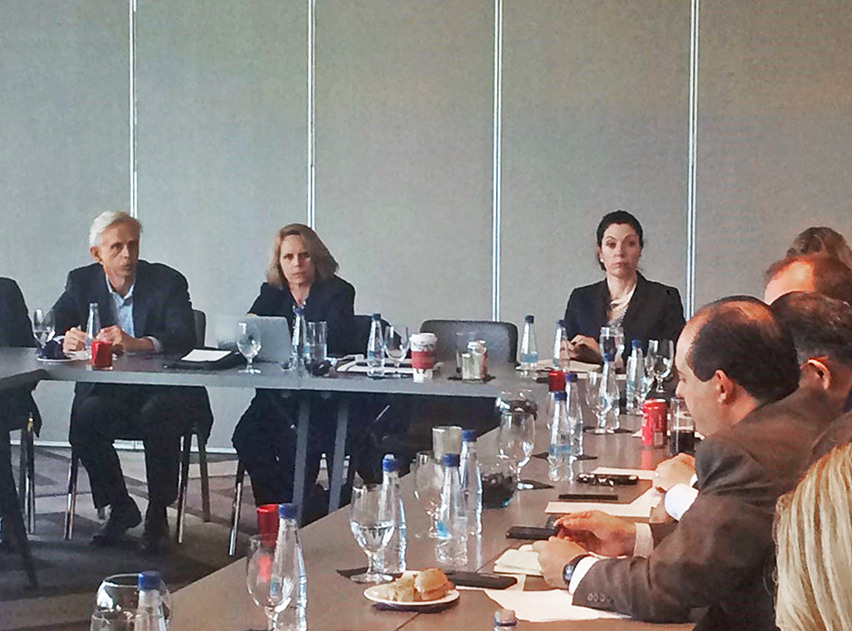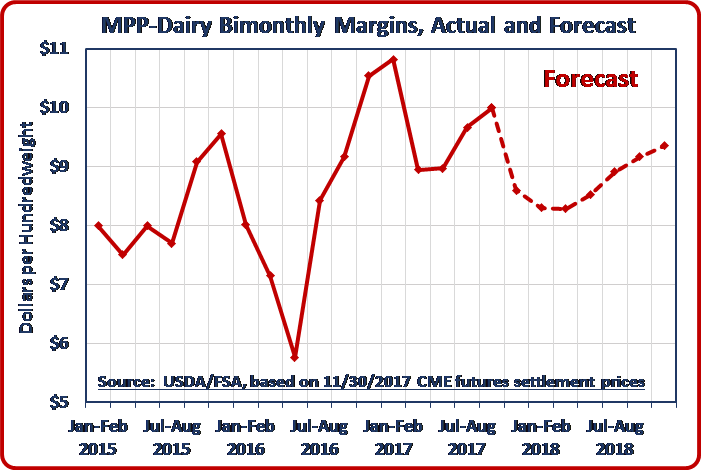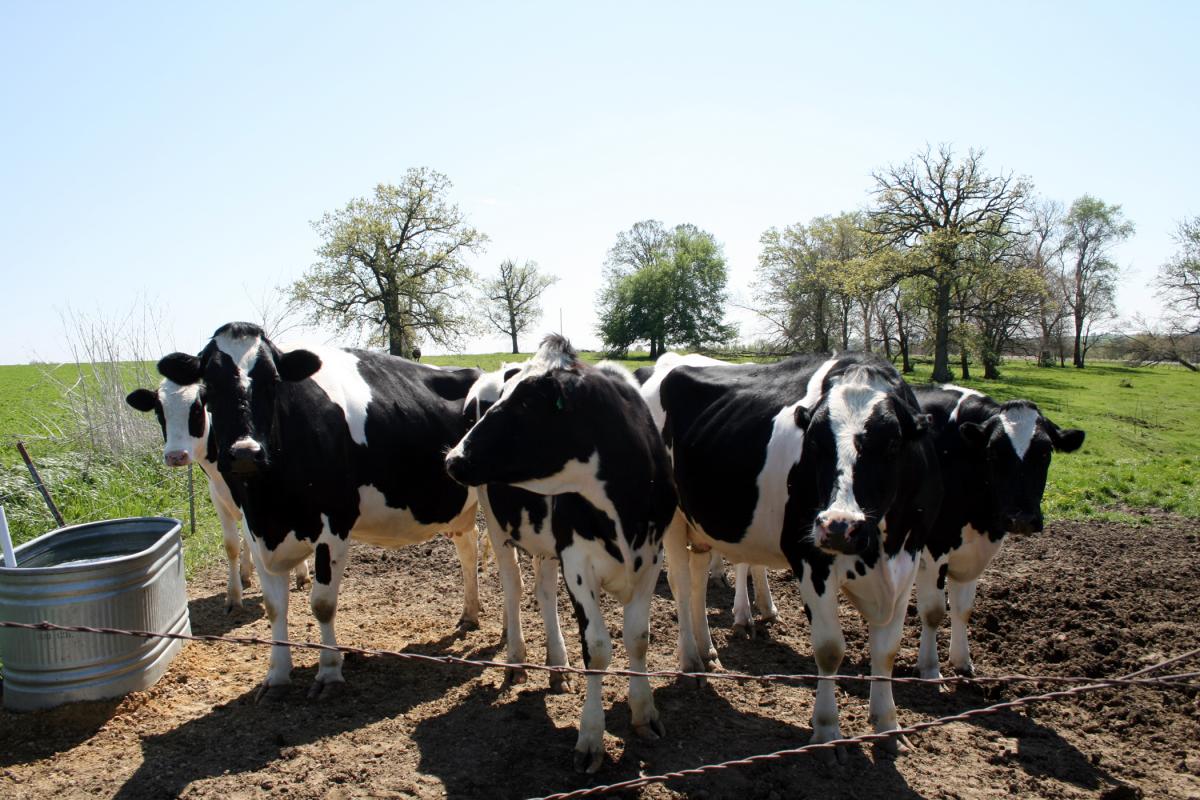Congress Working to Complete Tax Reform Legislation Before End of Year
December 08, 2017 As 2017 draws to a close, Congress’ top priority is overhauling the current federal tax code. The U.S. House of Representatives and Senate each has passed their own tax reform bills, and are now reconciling the two versions to send a final bill to President Trump’s desk before the holidays. NMPF is working closely with members of Congress to shape the massive, complicated legislation so that it delivers a positive outcome for dairy farmers and their cooperatives.
As 2017 draws to a close, Congress’ top priority is overhauling the current federal tax code. The U.S. House of Representatives and Senate each has passed their own tax reform bills, and are now reconciling the two versions to send a final bill to President Trump’s desk before the holidays. NMPF is working closely with members of Congress to shape the massive, complicated legislation so that it delivers a positive outcome for dairy farmers and their cooperatives.
NMPF is working with others in agriculture to preserve the benefits that farmers and cooperatives enjoy from the Domestic Production Activities Deduction (DPAD), also known as Section 199. NMPF has long supported this deduction, which cooperatives claim on the proceeds from sales of agricultural products like milk. Cooperatives pass through a majority of the benefit – nearly $2 billion nationwide – directly to their farmer owners, and reinvest the remaining proceeds in infrastructure improvements to help both the farmer and the cooperative.
While the House and Senate bills both repeal DPAD, the Senate legislation allows cooperative members to claim a new 23-percent deduction on their taxable income for qualified cooperative dividends, which refers to patronage dividends, per-unit retain allocations, qualified written notices of allocations, and similar amounts. Cooperatives could also claim the 23-percent deduction on taxable income, but it would be limited to 50 percent of their wages. NMPF is attempting to improve these provisions to ensure that the final tax reform legislation continues to recognize the unique nature of how cooperatives are taxed.
In addition to DPAD, NMPF is working on several other issues in the legislation of importance, including:
- Estate Tax Relief – NMPF supports repealing the federal estate tax, which penalizes the transfer of farms between generations of family members. The House and Senate bills both make additional progress on this issue. The House doubles the existing exemption to $11 million for individuals and $22 million for couples, and fully repeals the tax after 2023. The Senate similarly doubles the exemption levels, but leaves the tax in place. Importantly, both bills preserve a full stepped-up basis for inherited property, thereby avoiding what could have been another tax increase to offset repealing or reducing the estate tax.
- Depreciation – Both the House and Senate bills would allow farms and other businesses to immediately write off 100 percent of qualified property costs through 2022. Current law allows businesses a 50-percent write-off for 2017, which decreases in the coming years.
- Expensing – The House and Senate take different approaches to expanding the Section 179 provision made permanent by the NMPF-backed 2015 PATH Act. The House bill would temporarily increase the maximum allowance from $500,000 to $5 million through 2022, and would expand the provision to cover used and new equipment. The Senate bill would permanently adjust the maximum allowance to $1 million, but would not expand the provision to include used equipment.
- Interest Deductibility – Both bills attempt to preserve the business interest deduction for most farmers. The House bill allows farms with less than $25 million in annual receipts to continue to deduct interest expenses, while the Senate bill allows farms with less than $15 million in annual receipts to continue to do so. However, the Senate bill exempts farms from that dollar limit if they agree to follow an alternative set of depreciation rules to offset the cost.
- Cash Accounting – Both the House and Senate measures would continue to allow farms to use cash accounting.
- Like-Kind Exchanges – Both the House and Senate would limit the use of Section 1031 like-kind exchanges to real property, removing their use for equipment.
- Environmental Stewardship – The House and Senate bills both phase down the Section 48 Investment Tax Credit is after several more years, per the 2015 PATH Act. Given the decision to let this tax credit expire, the Agriculture Environmental Stewardship Act to expand Section 48 to cover nutrient recovery systems and digesters was not incorporated into either chamber’s bill. NMPF will seek other legislative opportunities to address this issue over the coming months.
As the House and Senate work this month to prepare the final tax reform legislation, NMPF will remain closely engaged in seeking the best possible results on these issues.
NMPF Pushes Key Dairy Priorities During Fifth Round of NAFTA Talks in Mexico
December 08, 2017 NMPF President and CEO Jim Mulhern traveled to Mexico shortly before Thanksgiving to engage with negotiators from all three North American countries regarding the U.S. dairy sector’s key priorities for the modernization of the North American Free Trade Agreement (NAFTA).
NMPF President and CEO Jim Mulhern traveled to Mexico shortly before Thanksgiving to engage with negotiators from all three North American countries regarding the U.S. dairy sector’s key priorities for the modernization of the North American Free Trade Agreement (NAFTA).
During the fifth round of negotiations in Mexico City at the end of November, National Milk staff met with officials from the United States, Canada and Mexico to advance U.S. dairy interests in three key areas: preservation of full access to the Mexican market; opening the Canadian market to U.S. dairy products while eliminating Canada’s market-distorting Class 7 milk pricing scheme; and improving rules designed to safeguard trade access such as those addressing Sanitary and Phyto Sanitary requirements, and geographical indications (GIs).
“All negotiations must carefully calibrate competing agendas and achieve balanced trade-offs. Hopefully the NAFTA parties are beginning to recognize that progress comes only through dialogue that strengthens the pact by addressing its shortcomings,” Mulhern said about the recent round of negotiations. In the lead-up to the talks, as well as in their aftermath, a broad swath of organizations representing American agriculture remains concerned about preserving NAFTA, even as the Trump Administration works to improve it in important areas. NMPF has clearly and consistently underscored that withdrawal from NAFTA is not a viable option and would be devastating for the thousands of dairy farm families that rely on NAFTA to keep the door open to the industry’s No. 1 export market, Mexico.
NMPF, dairy cooperatives, state dairy associations and others in the dairy industry delivered that message to governors across the country last month in a joint letter that expressed concern about the potential U.S. withdrawal from NAFTA. More than 170 food and agriculture organizations and companies urged governors to “let President Trump know that you support a modernized NAFTA that maintains and enhances food and agricultural trade between the United States, Mexico and Canada,” and that withdrawal would have numerous adverse impacts on U.S. agriculture.
The letter was spearheaded by the NAFTA Food & Ag Trade Working Group, a coalition in which NMPF is involved, to ensure that American agriculture speaks with a united voice about the importance of preserving and improving NAFTA.
The sixth round of NAFTA discussions is scheduled for Jan. 23-28 in Canada. Negotiators hope to conclude a new deal by the end of March, as Mexico is holding elections later in 2018.
NMPF Work with Latin American Nations Leads to Favorable Policies on Food Names, WHO Guidelines
December 08, 2017While in Cuba at the end of November, National Milk staff worked with the Pan American Dairy Federation (FEPALE) to advance U.S. dairy farmers’ interests in preserving global markets for U.S. cheeses and upholding science-based international standards that support the critical nutritional role of dairy.
More than a dozen Latin American countries attended FEPALE’s annual general assembly last week in Havana. While there, NMPF Senior Vice President for Strategic Initiatives Jaime Castaneda discussed issues of mutual interest with counterparts from across the Americas. Because of those efforts, FEPALE passed two resolutions that align with key priorities for the U.S. dairy industry:
- Rejection of the European Union’s (EU) aggressive stance regarding the treatment of geographical indications (GIs). This is a topic of increasing relevance in Latin America, as the EU negotiates policies that benefit its own cheese products as it strikes deals with Mexico and the Mercosur bloc of countries, and prepares for talks with Chile in the near future. The resolution on current, past and future negotiations with the EU calls for no new GI restrictions on the use of commonly- used terms of importance to any country in the hemisphere.
- Resisting the World Health Organization’s (WHO) efforts to inappropriately incorporate broad policy guidelines (like restricting the promotion of milk and milk products to young children) in the Codex Alimentarius standards-setting process. The FEPALE resolution emphasizes the need for Codex standards to be based on high-quality science and objective criteria, which were not the basis of the WHO guidelines developed in 2016. It requested that the governments of the region object to incorporating WHO’s guidance into Codex standards and “continue to work with Codex under historical guidelines based on scientific foundations.”
NMPF staff have been working over the last several years to build a strong partnership with FEPALE members, an investment that helped shape the resolutions and generate support for them last week.
“The EU’s GI scheme and the WHO guidelines significantly threaten dairy trade and – more broadly – consumption,” said Castaneda. “We are very pleased that FEPALE recognized the dangers and took a strong stand in both cases.”
MPP Forecast: December
December 08, 2017 The monthly margins under the Margin Protection Program (MPP) were essentially the same for the two months of the most recent bimonthly period: $9.99/cwt for September and $10.00/cwt for October. The average margin for the September-October period was $9.996/cwt. The U.S. average all-milk price for October was $17.90/cwt, $0.10 higher than the September all-milk price. The MPP feed cost was $7.90/cwt for October, as reported by USDA’s Farm Service Agency (FSA), $0.09 higher than the feed cost for September. On a per-hundredweight-of-milk basis, the $0.09 feed cost increase was the net result of small changes in the feed cost components, which individually changed the formula calculation as follows: corn, -$0.01; soybean meal, $0.06; and alfalfa hay, $0.04.
The monthly margins under the Margin Protection Program (MPP) were essentially the same for the two months of the most recent bimonthly period: $9.99/cwt for September and $10.00/cwt for October. The average margin for the September-October period was $9.996/cwt. The U.S. average all-milk price for October was $17.90/cwt, $0.10 higher than the September all-milk price. The MPP feed cost was $7.90/cwt for October, as reported by USDA’s Farm Service Agency (FSA), $0.09 higher than the feed cost for September. On a per-hundredweight-of-milk basis, the $0.09 feed cost increase was the net result of small changes in the feed cost components, which individually changed the formula calculation as follows: corn, -$0.01; soybean meal, $0.06; and alfalfa hay, $0.04.
The CME grain futures currently indicate that the monthly MPP feed cost will rise slowly from its current level through the end of next year, but remain below $8.70/cwt throughout that time. The CME dairy futures currently indicate that the all-milk price will remain below $16.50/cwt during at least the first half of 2018. Combined, the futures indicate that the MPP margin will drop below $8.00/cwt but remain above $7.50/cwt during the second, third and fourth bimonthly periods next year. The USDA MPP Decision Tool margin forecast for next year has moved a bit higher over the past month. As shown in the chart, the USDA tool projects that the MPP margin will remain above $8.00/cwt throughout 2018, with less than a 50-percent probability that it will fall below that level, based on the Nov. 30 CME futures settlements.
USDA’s MPP margin forecasts are updated daily online. NMPF’s Future for Dairy website offers a variety of educational resources to help farmers make better use of the program.
CWT Members Secure 8.8 Million Pounds of Cheese and Butter Export Sales
December 08, 2017 Cooperatives Working Together helped its member cooperatives last month to capture 56 contracts to sell 8.77 million pounds of American-type cheese and 55,116 pounds of butter to customers in Asia, Central America, the Middle East, North Africa and Oceania. The product will be shipped during the months of November 2017 through January 2018.
Cooperatives Working Together helped its member cooperatives last month to capture 56 contracts to sell 8.77 million pounds of American-type cheese and 55,116 pounds of butter to customers in Asia, Central America, the Middle East, North Africa and Oceania. The product will be shipped during the months of November 2017 through January 2018.
These recent transactions raise the total CWT-assisted year-to-date net product sales to 67.32 million pounds of cheese and 4.81 million pounds of butter. The product is going customers in 21 countries in five regions, and will move overseas the equivalent of 729.45 million pounds of milk on a milkfat basis.
Helping CWT member cooperatives gain and maintain world market share through the Export Assistance program in the long-term expands the demand for U.S. dairy products and the U.S. farm milk that produces them. This, in turn, positively impacts all U.S. dairy farmers by strengthening and maintaining the value of dairy products that directly affects their milk price.
The amounts of dairy products and related milk volumes reflect current contracts for delivery, not completed export volumes. CWT will pay export assistance to the bidders only when export and delivery of the product is verified by the submission of the required documentation.
All cooperatives and dairy farmers are encouraged to add their support to this important program. Membership forms are available on the CWT website.
Air Emissions Reporting Still Not Required After Court Further Stays Mandate Until January
December 08, 2017 National Milk’s advice to dairy operators not to file air emissions reports with the National Response Center was affirmed Nov. 22 after the D.C. Court of Appeals granted the U.S. Environmental Protection Agency’s (EPA) motion to further stay until January a mandate that could eventually lead to a reporting requirement.
National Milk’s advice to dairy operators not to file air emissions reports with the National Response Center was affirmed Nov. 22 after the D.C. Court of Appeals granted the U.S. Environmental Protection Agency’s (EPA) motion to further stay until January a mandate that could eventually lead to a reporting requirement.
At issue is the lengthy court battle over whether large livestock operations must report ammonia and hydrogen sulfide manure emissions under either the Comprehensive Environmental Response, Compensation, and Liability Act (CERCLA) regulation, and/or the Emergency Planning Community Right to Know Act (EPCRA). Last April, the U.S. Court of Appeals for the District of Columbia ruled that a 2008 reporting exemption granted by EPA was improper. EPA asked for and was granted a stay of the appeals court’s decision, but that stay ended on Nov. 14.
The stay’s expiration last month caused a great deal of confusion because many interested parties believed the expiration of the stay automatically triggered the reporting requirement. However, as NMPF repeatedly advised its members, the appeals court must first issue a mandate to EPA initiating the reporting requirement. The court did not issue its mandate to EPA and, in fact, on Nov. 22, the D.C. Court of Appeals granted EPA’s motion to further stay the mandate until Jan. 22, 2018.
NMPF is continuing to work with other animal agriculture organizations, the EPA and members of Congress to find a long-term solution which will preclude the need to file air emission reports stemming from the decomposition of manure. In case farmers do need to report, NMPF has prepared guidance and instructions on how to report and will hold a conference call to explain the process further.
NMPF Comments on FDA Education Program Highlight Volume of Misinformation on Bioengineering
December 08, 2017 In response to an FDA proposal to create a consumer education program on bioengineered foods, NMPF told the agency that in the interests of scientific integrity it must correct common misconceptions about the health and safety of such foods.
In response to an FDA proposal to create a consumer education program on bioengineered foods, NMPF told the agency that in the interests of scientific integrity it must correct common misconceptions about the health and safety of such foods.
Earlier this year, Congress instructed the U.S. Food and Drug Administration (FDA) to launch an education program to help consumers understand bioengineered foods and dispel misinformation about their origins and safety. In response to FDA’s request for input on this program, NMPF filed comments that expressed concern over the volume of inaccurate claims used in comments submitted by the public. National Milk urged FDA to catalog and refute every false notion and make them publicly available for stakeholder use.
NMPF also quoted FDA’s guidance on labeling bioengineered foods, noting that the agency had determined in a 1992 policy document that it was not aware of information that determined bioengineered foods differed from other foods in any meaningful way, and that there was no safety concern. NMPF suggested that because of the quantity of misinformation and anti-bioengineering rhetoric in the marketplace, every bioengineering claim – regardless of whether a product contains bioengineered ingredients – should bear an additional statement that says there is no material difference between a bioengineered food and a non-bioengineered food.
In addition, NMPF said FDA should work with the U.S. Department of Agriculture to develop materials that explain the benefits of bioengineering, including: less pesticide use, foods and feeds with better traits, and improved agricultural sustainability. The USDA, meanwhile, continues its work on a bioengineering label disclosure regulation, and NMPF expects that the agency will release a draft of the proposal in 2018.
FARM Program Hosts Final Evaluator Trainings, Forums for the Year
December 08, 2017The National Dairy FARM Program is wrapping up 2017 with several successful training and customer forums.
From November 13-15, the FARM Program hosted a FARM Animal Care Evaluator and Evaluator Trainer course in Albuquerque, N.M., with 20 veterinarians, veterinary students, cooperative staff and other industry personnel. Facilitated by Praedium Ventures, the course consisted of one day in the classroom and one day on a dairy farm. The classroom portion featured discussions on program history, evaluation methods and evaluation questions. Dairy Farmers of America member Jimmy Pareo of Belen, N.M., then led the group through an on-farm evaluation.
The FARM Program and the Innovation Center for U.S. Dairy cohosted the final customer forum of the year in Jacksonville, Fla. The October forum, the final of four held in 2017, shared the dairy industry’s focus on social responsibility with prominent national and international dairy customers. Representatives from grocery stores, sourcing companies and restaurant chains were in attendance.
During each two-day forum, educational sessions provided a deep dive into the FARM Program. Expert speakers shared insights into the rigorous standards of the program for animal care, environmental stewardship and antibiotic stewardship, as well as updates on emerging issues in the social responsibility arena. On the second day of the event, participants visited a local dairy farm to see the FARM Program in action.
Meanwhile, the National Dairy FARM Program, with Merck Animal Health, the University of Florida Extension and Southeast Milk, Inc. (SMI), will host a series of SMI membership trainings throughout Louisiana, Georgia and Florida during the week of December 11-15. These trainings will focus on creating a culture of cow care and continuous improvement; ensuring proper employee training and monitoring; creating and implementing standard operating procedures; and assessing farms’ vulnerabilities. For more information on these trainings, please contact Emily Meredith.
Dairy Sustainability Awards Now Taking Nominations
December 08, 2017The U.S. Dairy Sustainability Awards program is now taking nominations for 2018. Any dairy farm, business or community effort that demonstrates resourceful leadership and employs sustainable practices can be nominated.
These national awards bring deserved recognition to farmers, dairy companies and their partners that invest time and resources in continually improving their operations to benefit the environment, their community and their local economy. Four categories are available for nomination:
- Outstanding Dairy Farm Sustainability
- Outstanding Supply Chain Collaboration
- Outstanding Dairy Processing & Manufacturing Sustainability
- Outstanding Community Impact
Nominations will be judged on measurable results; approach and innovative use of resources; communication of learnings; and the potential for adoption by other farms/businesses. The deadline to nominate a person or group is Monday, Feb. 12, 2018. Winners will be announced during a ceremony in Chicago in May later that year. For inspiration, take a look at the stories from past winners and then download a nomination form.
For additional details about the program, contact Jennifer.Block@dairy.org or your local dairy promotion organization.
USDA Announces Regulation that Would Allow Low-Fat Flavored Milk Back into Schools
December 08, 2017Low-fat (1%) flavored milk will be returning to schools now that the U.S. Department of Agriculture announced new regulatory changes in late November. An interim final rule implements the changes needed to reinstate low-fat flavored milk in schools, and goes into effect in time for milk processors to negotiate supply contracts for the 2018-2019 school year.
The regulation follows changes USDA Secretary Sonny Perdue initially proposed earlier this year to streamline the process by which schools can serve low-fat flavored milk. In 2012, USDA implemented new regulations that required that schools only offer fat-free flavored milk, mostly to reduce calories. Participation rates in school meal programs fell, with students consuming 288 million fewer half-pints of milk from 2012-2015, even though public school enrollment was growing. NMPF and the International Dairy Foods Association worked together to persuade Congress to address the issue.
“Secretary Perdue’s willingness to provide greater flexibility to schools recognizes that a variety of milks and other healthy dairy foods is critically important to improving the nutritional contributions of child nutrition programs in schools,” said Jim Mulhern, president and CEO of the National Milk Producers Federation (NMPF).
In October, Reps. G.T. Thompson (R-PA) and Joe Courtney (D-CT) introduced the bipartisan School Milk Nutrition Act of 2017, which would allow schools to offer low-fat and fat-free milk, including flavored milk with no more than 150 calories per 8-ounce serving. The bill allows individual schools and school districts to determine which milkfat varieties to offer their students.
The publication of the interim final rule allows school districts to solicit bids for low-fat flavored milk next spring before the 2018-19 school year begins, giving milk processors time to formulate and produce a low-fat flavored milk that meets the specifications of a particular school district.
NMPF will file comments in response to the proposed rule, expressing strong support for permitting schools to offer 1% flavored milk on a permanent basis. After taking comments, USDA will issue a final rule next fall that is expected to extend the regulation to school years after 2018-2019.
As science continues to suggest health benefits from higher-fat milk varieties, NMPF continues to take a leadership role in encouraging this newer science to be incorporated in school meals and dietary guidelines.






